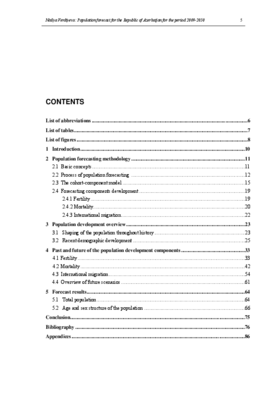Population forecast of the Republic of Azerbaijan for the period 2009-2050
diplomová práce (OBHÁJENO)

Zobrazit/
Trvalý odkaz
http://hdl.handle.net/20.500.11956/27005Identifikátory
SIS: 82484
Kolekce
- Kvalifikační práce [20329]
Autor
Vedoucí práce
Oponent práce
Burcin, Boris
Fakulta / součást
Přírodovědecká fakulta
Obor
Demografie
Katedra / ústav / klinika
Katedra demografie a geodemografie
Datum obhajoby
15. 2. 2010
Nakladatel
Univerzita Karlova, Přírodovědecká fakultaJazyk
Angličtina
Známka
Velmi dobře
Klíčová slova (česky)
Population development, forecast, AzerbaijanKlíčová slova (anglicky)
Population development, forecast, AzerbaijanThe main purpose of the study was to produce a population forecast by sex and one-year age groups for the Republic of Azerbaijan for the period 2009-2050. The forecasting process consisted from the several stages, which are included in the general structure of the production process of a forecast. During the data analysis, a number of methods were applied: redistributional methods of intensities, method of reconstruction abridge life tables into complete life tables, application of the Kannisto method to describe mortality in the old ages. The estimated one-year intensities were utilized in the current trends analysis serving as a background for forecasting the parameters of the cohort-component projection model. During the population forecasting the cohort-component projection model was used and population was forecasted in three scenarios (variants). Underlying assumptions were based on analysis of the recent demographic trends and an assessment of their implications for future changes. Keywords: forecast, population development, Azerbaijan
The main purpose of the study was to produce a population forecast by sex and one-year age groups for the Republic of Azerbaijan for the period 2009-2050. The forecasting process consisted from the several stages, which are included in the general structure of the production process of a forecast. During the data analysis, a number of methods were applied: redistributional methods of intensities, method of reconstruction abridge life tables into complete life tables, application of the Kannisto method to describe mortality in the old ages. The estimated one-year intensities were utilized in the current trends analysis serving as a background for forecasting the parameters of the cohort-component projection model. During the population forecasting the cohort-component projection model was used and population was forecasted in three scenarios (variants). Underlying assumptions were based on analysis of the recent demographic trends and an assessment of their implications for future changes. Keywords: forecast, population development, Azerbaijan
